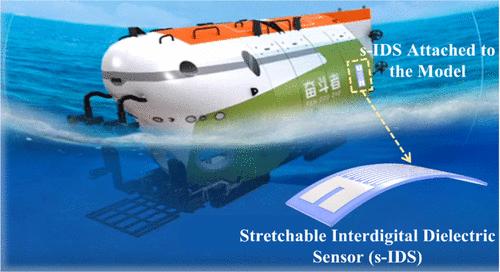Our official English website, www.x-mol.net, welcomes your
feedback! (Note: you will need to create a separate account there.)
A Three-Dimensional Surface-Adaptive Stretchable Sensor for Online Monitoring of Composite Materials Curing
ACS Sensors ( IF 8.2 ) Pub Date : 2024-10-29 , DOI: 10.1021/acssensors.4c02022 Wei Wang, Bowen Zhang, Haonan Feng, Zihong Wei, Zhuhang Dai, Hai Zhang, Haoxiang Ma, Yaxiaer Yalikun, Chenjing Shang, Yang Yang
ACS Sensors ( IF 8.2 ) Pub Date : 2024-10-29 , DOI: 10.1021/acssensors.4c02022 Wei Wang, Bowen Zhang, Haonan Feng, Zihong Wei, Zhuhang Dai, Hai Zhang, Haoxiang Ma, Yaxiaer Yalikun, Chenjing Shang, Yang Yang

|
Recently, rigid sensors have been commonly applied to online monitoring of the core curing processes of composite materials to prevent both overcuring and under-curing. However, conventional rigid sensors are prone to causing cracks and bubbles in composite materials during the curing process, thereby affecting both the mechanical performance and the overall reliability of the materials. Herein, stretchable interdigital dielectric sensors with flexible substrates and electrodes are designed to conform to complex 3D surfaces, thus enabling embedded nondestructive monitoring of composite curing processes. The sensors obtained can endure 1000 cycles of bending from 0° to 180° and 1000 cycles of stretching at 30% strain while still conforming perfectly to complex 3D surfaces, thus overcoming the inability of traditional curing monitoring sensors to bend. Additionally, sensor integration with an electronic circuit enables real-time data collection and transmission, which makes the device more portable, compact, and lightweight. Moreover, after atmospheric exposure for 5 months, the unit sensitivity of the sensor decreased by only 0.1%, thus demonstrating its excellent reliability and stability. Furthermore, during curing monitoring of the complex three-dimensional surfaces of the Fendouzhe deep-sea submersible, the unit’s sensitivity is close to that of conventional planar monitoring equipment, decreasing by only 0.4%. The proposed online nondestructive monitoring technology demonstrates high sensitivity, high monitoring accuracy, and high reliability during surface monitoring, thus enabling long-term curing monitoring under complex nonplanar conditions.
中文翻译:

一种用于复合材料固化在线监测的三维表面自适应可拉伸传感器
最近,刚性传感器已普遍应用于复合材料核心固化过程的在线监测,以防止过度固化和欠固化。然而,传统的刚性传感器在固化过程中容易导致复合材料出现裂纹和气泡,从而影响材料的机械性能和整体可靠性。在此,具有柔性基板和电极的可拉伸数字间介电传感器被设计为符合复杂的 3D 表面,从而能够对复合材料固化过程进行嵌入式无损监测。获得的传感器可以承受 1000 次从 0° 到 180° 的弯曲循环和 1000 次 30% 应变的拉伸循环,同时仍然完美地适应复杂的 3D 表面,从而克服了传统固化监测传感器无法弯曲的问题。此外,传感器与电子电路的集成可实现实时数据收集和传输,这使得该设备更加便携、紧凑和轻便。此外,在大气暴露 5 个月后,传感器的单位灵敏度仅下降了 0.1%,从而证明了其出色的可靠性和稳定性。此外,在对 Fendouzhe 深海潜水器的复杂三维表面进行固化监测时,该装置的灵敏度接近传统平面监测设备,仅降低 0.4%。所提出的在线无损监测技术在表面监测过程中表现出高灵敏度、高监测精度和高可靠性,从而能够在复杂的非平面条件下进行长期固化监测。
更新日期:2024-10-29
中文翻译:

一种用于复合材料固化在线监测的三维表面自适应可拉伸传感器
最近,刚性传感器已普遍应用于复合材料核心固化过程的在线监测,以防止过度固化和欠固化。然而,传统的刚性传感器在固化过程中容易导致复合材料出现裂纹和气泡,从而影响材料的机械性能和整体可靠性。在此,具有柔性基板和电极的可拉伸数字间介电传感器被设计为符合复杂的 3D 表面,从而能够对复合材料固化过程进行嵌入式无损监测。获得的传感器可以承受 1000 次从 0° 到 180° 的弯曲循环和 1000 次 30% 应变的拉伸循环,同时仍然完美地适应复杂的 3D 表面,从而克服了传统固化监测传感器无法弯曲的问题。此外,传感器与电子电路的集成可实现实时数据收集和传输,这使得该设备更加便携、紧凑和轻便。此外,在大气暴露 5 个月后,传感器的单位灵敏度仅下降了 0.1%,从而证明了其出色的可靠性和稳定性。此外,在对 Fendouzhe 深海潜水器的复杂三维表面进行固化监测时,该装置的灵敏度接近传统平面监测设备,仅降低 0.4%。所提出的在线无损监测技术在表面监测过程中表现出高灵敏度、高监测精度和高可靠性,从而能够在复杂的非平面条件下进行长期固化监测。


















































 京公网安备 11010802027423号
京公网安备 11010802027423号